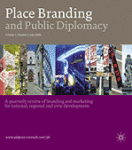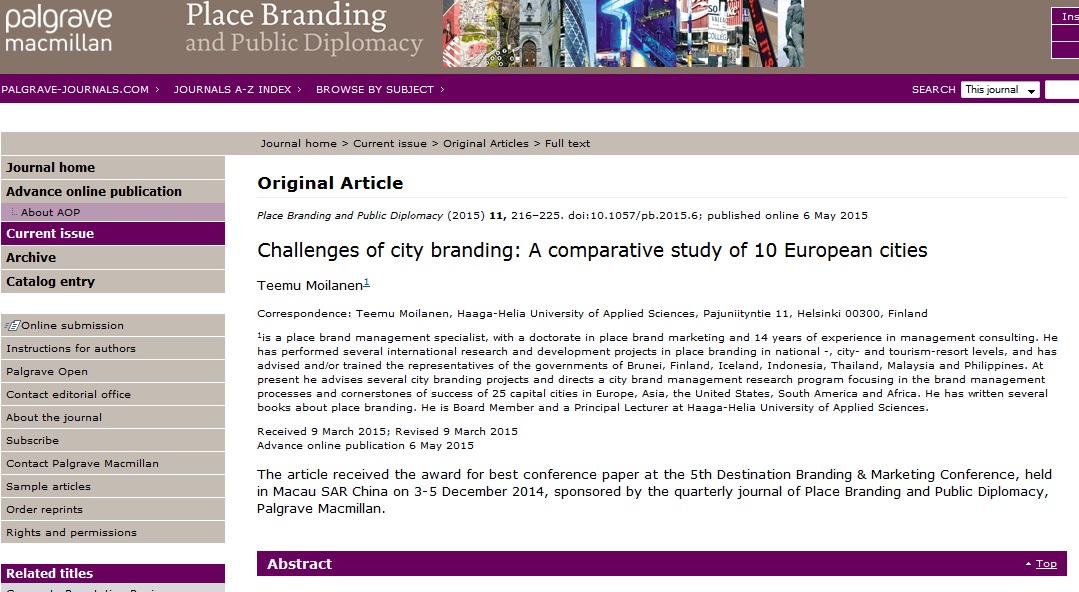In today’s post we take a look at some of the main city branding challenges encountered by those in charge of place brand strategy and implementation. The latest edition of the Place Branding and Public Diplomacy Journal contains an article by Teemu Moilanen on the challenges faced by city brand managers when they attempt to create and sustain the brands of their cities.
The article received the award for best conference paper at the 5th Destination Branding & Marketing Conference, held in Macau SAR China on 3-5 December 2014, sponsored by the quarterly journal of Place Branding and Public Diplomacy, co-edited by Nick Cull and Robert Govers.
9 City Branding Challenges: Summary of Research Insights
This comparative study examines challenges faced in the city branding processes of 10 European cities and is based on interviews with 17 high-ranking city branding practitioners.
Nine major city branding challenges were identified:
- large number of stakeholders;
- limited understanding of branding among key stakeholders;
- limited internal buy-in among stakeholders;
- difficulties in securing sufficient funding;
- general slowness and time related challenges;
- organizational issues and lack of authority to lead;
- operational level challenges in marketing communication campaigns and in transferring the brand identity to product experiences;
- formulation of strategy;
- poor situational awareness resulting from poor monitoring.
1. Large number of stakeholders
The first of the city branding challenges identified in the study – large number of stakeholders – was brought up in nine out of ten case cities and appears to have three major aspects. The process of place branding requires participation of large number of stakeholders ranging from public sector organizations to firms and non-profit organizations, who have different objectives. A significant proportion of the stakeholders have conflicting and parallel activities.
The share number of stakeholders makes it difficult to include all relevant parties in city brand planning process. As one participant stated:”There are many authorities, and most of them have conflicting and parallel activities. And this creates a major problem when it comes to brand development, because all these agencies and all these public bodies are doing their own campaigns, and most of them without being in coordination with the others.”
2. Limited understanding of branding among stakeholders
The second city branding challenge, identified by the practitioners in eight out of ten case cities, is the limited understanding of branding within the network of stakeholders.
Marketing in general, and branding in particular, is foreign to many public sector stakeholder organizations and individuals, who occasionally reject it as too commercial. Similarly, public sector representatives have a narrow view of branding (perceived as logo planning) or do not understand the purpose and process of branding at all, and accordingly it is difficult to make all relevant stakeholders understand that they do have a role in the development of city brand.
This has led to conceptual ambiguity and varying understandings of objectives and the potential means to achieve them. As one participant stated:”And that’s where I say going back to who runs the city branding process and communication process, having governmental city authorities running it, maybe that’s not their area of expertise, maybe that’s why it’s difficult to think of the city as a place you’re selling.”
3. Securing sufficient internal buy-in from public sector organizations
The third city branding challenge identified is the difficulty in securing sufficient internal buy-in from public sector organizations, the private sector and citizens. A major feature, identified by practitioners in nine out of 10 case cities, is the challenge of securing sufficient political support from the public sector and city hall. The private sector is more familiar with branding as a concept.
However, it is challenging to mobilize private sector organizations to participate in the city branding process, and to find ways to make the organization in charge of city branding relevant for private sector actors. As one participant stated:”… we will have to collaborate to do the branding of the city with other administrations and of course and most of all with the private sector, which have to become the main drivers, in my opinion, of the branding of the city … The ones who have thousands of commercial guys selling their hotels, selling the restaurants, selling the museums, selling whatever. And they are the ones who will have to collaborate in branding the city. In my opinion, what we have to do is to become useful for this private sector in giving them the tools and the means to do this branding.”
The citizens’ opinion and participation in the city branding process is considered important, since empowering them to become ambassadors of the city brand would be highly beneficial for the process. However, actually attaining citizens’ involvement in the brand management process is a major difficulty. As two participants stated:”It’s really important that the whole city can be part of it and feels the slogan and it’s really like “yeah, that’s what the city is”. And I think this is really really difficult.”
4. Securing sufficient funding
Securing sufficient funding is the fourth city branding challenge, identified in nine out ten case cities. A major element of this challenge is the need to convince public sector decision makers that branding is an investment with positive return on investment.
Limited funding leads to other difficulties, including the need to make compromises, eliminate necessary activities, and limited or non-existent market research. To a lesser extent, attracting funding from private sector stakeholders also is problematic. As one participant stated: “And I try and try and try and try and say, talk about the revenue, talk about how much you’re making out of this. Because this is at the end of the day what .. Or employment, how many jobs have been created.”
5. Slowness and time related issues
The fifth city branding challenge identified by the city brand practitioners is slowness and time related issues. Large numbers of stakeholders increase the time needed for internal communication and decision-making, and generally slow down several phases of the brand management process.
Funding-related decisions made in the public sector are often delayed. Private sector actors are generally faster than public sector stakeholders, leading to frustration at one end and feelings of haste at the other end. As one participant stated:”I think this is difficult in a city … because there are lots of people to be involved then and it takes time. Every process, every idea you have takes lots of time.”
6. Organizational issues
The sixth city branding challenge identified by the practitioners is related to organizational issues. This challenge appears to be a composite of two major features: conflicting opinions of key stakeholders, combined with lack of clear leadership. These are exacerbated by an unclear decision-making structure, limited coordination between stakeholders, stakeholder’s fear of losing power when engaging in a cooperative branding process and the challenge of building an effective system for internal communication within a loosely structured network organization.
The lack of a linkage appears to be the main difficulty in finding individuals or organizations to be in charge of the process. As two participants stated:”… so this is the hardest to find who has the responsibility, if you don’t have a strong city mayor who says “I do”.I’m quite sure you could also find models where you do not have an institution on the top. But if you do not have like an institution on top, then still you have to answer the question who is the body that takes care of the brand and does the monitoring, for instance. The problem is somebody has to be in charge, but whom?”
7. Operational brand management
The seventh city branding challenge is related to operational level brand management, and it was brought up in 9 of the 10 case cities. This challenge appears to have two major components. The first one is a set of issues related to the difficulties caused by day-to-day management of the external marketing communication campaign.
These include difficulties in combining city branding activities with the activities of a single stakeholder, difficulties in finding ways to help stakeholders to use the brand, lack of marketing skills, parallel activities and inconsistent messages. The second component is the difficulty in transferring the brand identity to product experience. In other words, how to move from words to action, to diminish the gap between marketing and the reality experienced by visitors.
8. Formulation of strategy for the city brand
The eighth city branding challenge is related to the formulation of strategy for the city brand. It is a composite of several smaller interlinked issues, that is, the difficulty in identifying target groups, defining brand identity, differentiating from competitors, focusing on the wrong competitors, difficulties in tailoring the marketing message to different markets and customer segments, difficulty in defining the relationship between the city brand and the regional/national brand, and general lack of strategic thinking and dialog.
Challenges related to brand identity definition appear to be closely linked to the first two challenges discussed in the literature review; determining if there is a common and collective character in this complex entity of products/services that could be captured by a single brand and simply reaching a common agreement as to what is being marketed/branded. Several interviewees also emphasized that a city is a highly complex product, but in many ways similar to other cities.
9. Monitoring and poor situational awareness
Finally, monitoring and poor situational awareness was identified as a considerable city branding challenge in 5 out of 10 case cities. Interlinked features of this challenge are the lack of good measures for brand success, utilization of wrong measures and use of unsophisticated monitoring tools. Combined, these features lead to poor situational awareness and market understanding, inefficient use of resources and failure to justify actions and budget requirements to decision makers.
To learn more about this study on the key city branding challenges in Europe and to access the whole paper, visit palgrave-journals.com.
 About Teemu Moilanen
About Teemu Moilanen
Teemu is a place brand management specialist, with a doctorate in place brand marketing and 14 years of experience in management consulting. He has performed several international research and development projects in place branding in national -, city- and tourism-resort levels, and has advised and/or trained the representatives of the governments of Brunei, Finland, Iceland, Indonesia, Thailand, Malaysia and Philippines.
At present he advises several city branding projects and directs a city brand management research program focusing in the brand management processes and cornerstones of success of 25 capital cities in Europe, Asia, the United States, South America and Africa. He has written several books about place branding. He is Board Member and a Principal Lecturer at Haaga-Helia University of Applied Sciences.
Read our interview with Teemu Moilanen
 About Place Branding and Public Diplomacy
About Place Branding and Public Diplomacy
Place Branding and Public Diplomacy is the first and only journal to concentrate on the practice of applying brand strategy and other marketing techniques and disciplines to the economic, social, political and cultural development of cities, regions and countries.
The Place Brand Observer has teamed up with academic publisher Palgrave to share with you key insights and findings from articles published in their quarterly flagship journal, Place Branding and Public Diplomacy, edited by Robert Govers and Nick Cull. Read more
Enjoyed this summary of research by Teemu Moilanen on the key city branding challenges in Europe? Spread the word!


